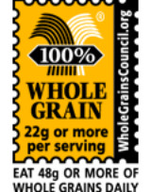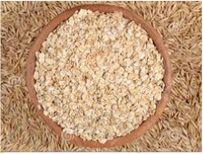
Scientists and government guidelines recommend that all adults eat at least three servings (48g) of whole grain each day. The Whole Grain Council developed this stamp that will enable you to figure out if you are getting the recommended servings per day. You may have noticed this stamp on some products at the grocery store. I do think it helps but don't assume that the product is 100% whole grain. You must look closely at the whole grain stamp, there are 2 basic types of stamps.
Basic Stamp or 100% Stamp?
Each Stamp also shows a number, telling you how many grams of whole grain ingredients are in a serving of the product. When you look on your grocery shelves you'll see a wide range of numbers, reflecting the whole grain content of a serving of that specific product.
How it Works
Let's say you have four breakfast cereals sitting on a shelf. They each have a serving size of 30 grams, but they're made up of different ingredients.
Basic Stamp or 100% Stamp?
- If a product bears the 100% Stamp, then all its grain ingredients are whole grains. There is a minimum requirement of 16g (16 grams) a full serving – of whole grain per labeled serving, for products using the 100% Stamp. There is a bit of a loop hole here "per labeled serving". The company decides what is the serving size of the product.
- If a product bears the Basic Stamp, it contains at least 8g (8 grams) – a half serving – of whole grain, but may also contain some refined grain. Even if a product contains large amounts of whole grain (23g, 37g, 41g, etc.), it will use the Basic Stamp if it also contains extra bran, germ, or refined flour.
Each Stamp also shows a number, telling you how many grams of whole grain ingredients are in a serving of the product. When you look on your grocery shelves you'll see a wide range of numbers, reflecting the whole grain content of a serving of that specific product.
How it Works
Let's say you have four breakfast cereals sitting on a shelf. They each have a serving size of 30 grams, but they're made up of different ingredients.
- Cereal A: whole oats (22 grams), walnuts (5 grams), raisins (3 grams)
- Cereal B: whole oats (15 grams), walnuts (7 grams), raisins (5 grams), coconut (3 grams)
- Cereal C: whole oats (27 grams), oat bran (3 grams)
- Cereal D: corn flour (12 grams), whole oats (9 grams), raisins (5 grams), sugar (4 grams)
| Cereal A This cereal would qualify for the 100% Stamp, 22g or more. All its grains are whole grains, and it contains more than 16g of whole grain. Cereal B This cereal would qualify for the Basic Stamp, 15g or more. All its grains are whole grains, but it doesn't meet the minimum of 16g of whole grains required for the 100% Stamp Cereal C This cereal would qualify for the Basic Stamp, 27g or more. Although bran is a very healthy component of grains, it's not a WHOLE grain, so the 100% Stamp can not be used on this product. Cereal D This cereal would qualify for the Basic Stamp, 9g or more. The first ingredient is corn flour, a refined grain. Cereal D isn't as healthy as the first three examples, but it might be a good choice for someone who previously ate cereals with no whole grain and note the 12g of sugar (that's 3 teaspoons!). |
The Stamp makes it easy to get your recommended three servings or more of whole grains each day:
http://wholegrainscouncil.org
- Eat three whole grain food products labeled "100% Whole Grain" OR
- Eat six products bearing ANY Whole Grain Stamp
http://wholegrainscouncil.org


 RSS Feed
RSS Feed
